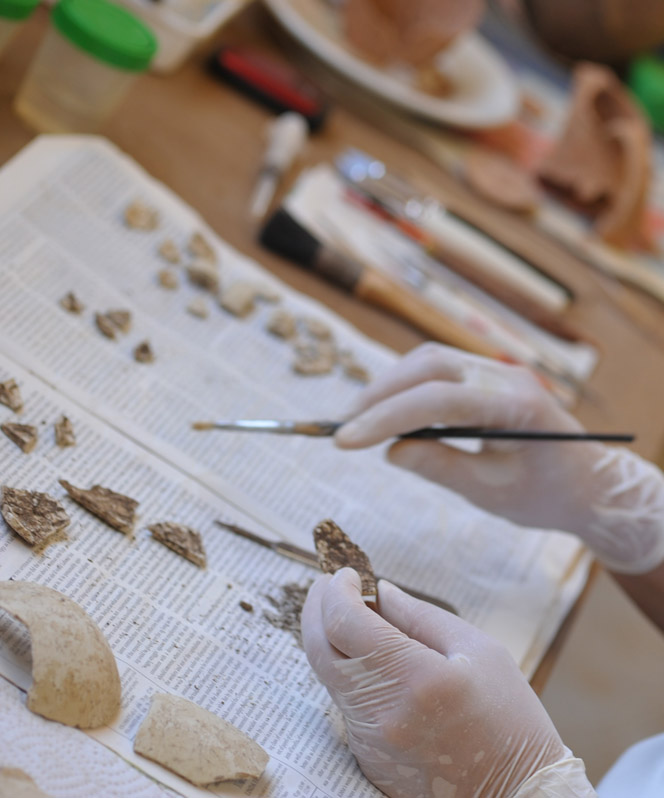ARCHAEOLOGY
Besides growing grapes and making wine, Casale del Giglio has been involved for some time in the Satricum archaeological project in partnership with Southern Etruria’s Archaeological Heritage Office headed by Dr. Alfonsina Russo, a team from the University of Amsterdam headed by Dr. Marijke Gnade and a team from the town councils of Aprilia, Latina and Nettuno. Dr. Francesco di Mario is responsible for the management of the Satricum archaeological area.
Excavations have exposed the ‘Sacred Way’ which led to the temple of the goddess Mater Matuta and have uncovered a ceramic wine goblet dating from the V century B.C.
History of the Excavations
The story of the Satricum excavations takes us back to the year 1896 when a Frenchman, Hector Graillot, discovered the remains of the temple dedicated to the goddess Mater Matuta on a hillside near the village of Le Ferriere and for the next two years carried out extensive excavations under the guidance of a team of Italian archaeologists. Many remains were unearthed and entrusted to the Villa Giulia Museum in Rome.
Nothing further was done until 1907-1910 when excavation work was undertaken again. Around 1975, Latium’s Committee for Archaeology invited the Dutch Institute of Rome to take up the excavations at the Satricum site.
The Dutch team’s most significant find in their twenty-five year dig was that of the Lapis Satricanus or Stone of Satricum, a stone slab, probably the base of a column, inscribed in ancient Latin and dating from between 525-500 B.C.
Since 1990 the excavation work at the site has been carried out by a team from the University of Amsterdam, headed by Professor Marijke Gnade.
The Sanctuary of Mater Matuta
The first testimony to the existence of a cult on the acropolis of Satricum is that of an early hut which dates from the period between the VIII and VII centuries B.C. At some time between 640 and 625 B.C. this structure was replaced by a sacellum, a small roofless shrine with stone foundations known as Temple Zero.
This was replaced around 540 B.C. by a much larger temple known as Temple I, while a still larger one, Temple II, was built around 500-480 B.C. when Temple I was destroyed.
Dwellings in Satricum
The first settlement in Satricum dates from the IX century B.C. when the population lived in huts situated on the hill where the acropolis would later stand.
Twenty-four of these huts were excavated in the 19th century. (Since 1977 a further fifteen have been found). The VII century B.C. saw the use of stone as a building material for the first time.
Throughout the VI century B.C. the huts were totally replaced by houses with stone foundations and walls of sun-dried clay bricks.
Many buildings with stone foundations which once surrounded the temples have been brought to light on the Satricum acropolis.
It is thought that these buildings were part of the shrine and may have been lodgings for priests or for guests.
The earliest northwest acropolis
The proto-historic necropolis of Satricum covered an area to the west and northwest of the acropolis. It was partially explored during the Italian excavations at the end of the 19th and the beginning of the 20th century.
Dozens of tombs were opened and found to contain sumptuous funeral ornaments considered today to be among the most important ever discovered in Latium Vetus . These tombs made up a tiny part of the necropolis which has now completely disappeared.
The most ancient burials were of cremated remains while excavated tombs have disclosed a variety of ornaments and ceramics. The funeral customs of the Latin peoples changed towards the end of the VIII century B.C. and so the necropolis was abandoned.
The southwest necropolis (Volsca)
Research carried out to the southwest of the city in 1981 revealed a second necropolis dating from the V–IV century B.C. incorporating at least two hundred pit tombs.
The necropolis has been attributed to the Volsci who conquered Satricum in 488 B.C. and presumably remained there until the Romans founded a colony in 385 B.C.
There is substantial evidence that interment was the only form of burial practised at the time and the grave goods which have come to light consist mainly of simple vessels used for food and drink, personal items and weapons; the finding of a miniature axe inscribed in old italic ‘falisco-capenate’ characters is of particular significance.



